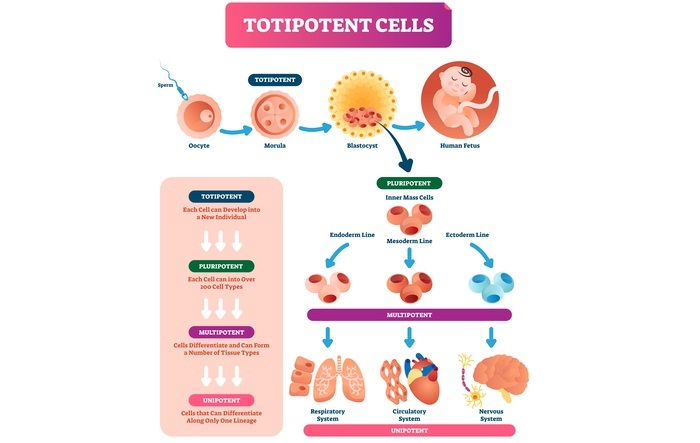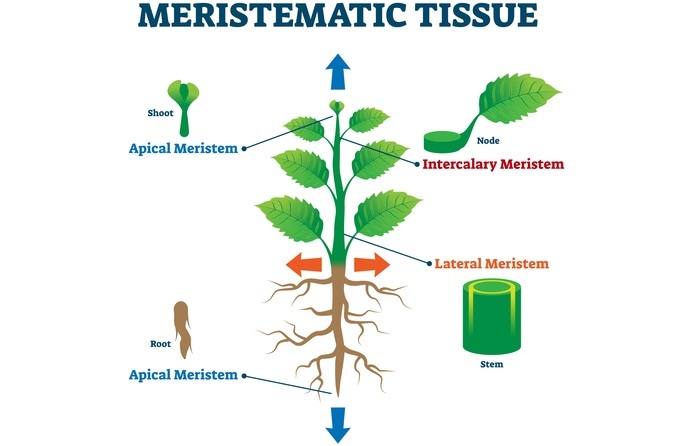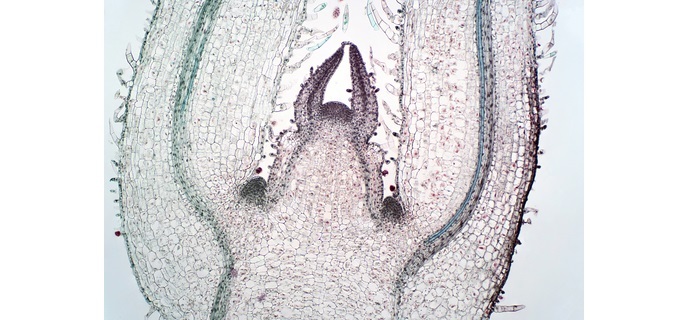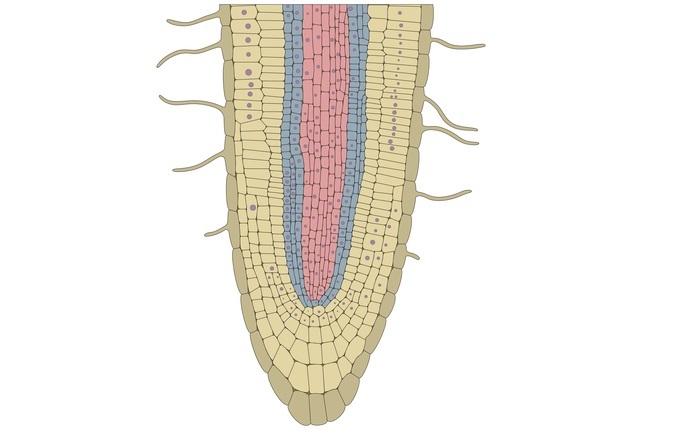
 Data Structure
Data Structure Networking
Networking RDBMS
RDBMS Operating System
Operating System Java
Java MS Excel
MS Excel iOS
iOS HTML
HTML CSS
CSS Android
Android Python
Python C Programming
C Programming C++
C++ C#
C# MongoDB
MongoDB MySQL
MySQL Javascript
Javascript PHP
PHP
- Selected Reading
- UPSC IAS Exams Notes
- Developer's Best Practices
- Questions and Answers
- Effective Resume Writing
- HR Interview Questions
- Computer Glossary
- Who is Who
Molecular Basis of Plant Organ Differentiation
Introduction
Totipotency is the ability of the cells to give rise to a whole new organism providing appropriate nutritional and environmental conditions. This property of Totipotency is seen in spores and zygotes. In plants, this Totipotency is seen in meristematic cells.

In Totipotency, every single cell can form either tissue, an organ, or an entire plant. Due to this property of plants, we can observe tissue regeneration.
Molecular Basis of Cellular Totipotency
Every organism has almost identical DNA and this genetic material is packaged with the help of histones and other remodeling complexes to form chromosomes or chromatin. This chromatin is free to get compacted or loosen up depending upon the developmental stage, surrounding environment, stress, nutritional availability, hormones, and other factors.
These factors decide and signal the cell either to divide and form an identical cell or a cell of identical function which usually happens during mitosis or these factors may program a cell by altering its chromatin structure allowing a specific set of genes to be turned on and others to remain off and differentiate to form another specialized type of cells.
This process is termed as cellular differentiation. And the obtained differentiated cell can form another cell of its own type or further differentiate and specializes in function or do not divide at all.
For example, it is the result of cell division and differentiation to give rise to various kinds of cell specialties by a stem cell that gives rise to a whole multicellular organism. However, under normal conditions, a differentiated cell type specialized to a specific fate cannot give rise to another cell type. But if factors such as hormones are altered appropriately a differentiated cell can undergo genetic reprogramming, become undifferentiated, and even re-differentiated to give rise to a different cell type with a different function.

This means we can take any live plant cell, provide the right factors and conditions and it is capable to rise to a whole plant. This is the basis of Totipotency in plants. Example: If you take cells from embryos that are already undifferentiated, which can naturally form a whole plant. But if we take a shoot apical meristem, it normally has the ability to form a shoot.
Likewise, root apical meristem will give rise to root only. But we can treat plants and alter the hormones or other factors in a way that you can make any cell that may be the shoot, root, or any other type of the cell to dedifferentiate, re-differentiate, divide and form a whole plant. It is due to Totipotency, with tissue culture one can rapidly generate billions of plants from plant tissue.
Differentiation in Plants
In plants, meristematic cells are known to be totipotent and the cells formed from these like sieve cells, leaf cells, root cells, etc., can be differentiated into different types of cells. Cells derived from the meristems differentiate and mature to perform specific functions. Cells lose the protoplasm and develop a lignocellulosic secondary cell wall to form treachery elements to carry water.
Leaf cells formed have different structures and functions from that of other cells like root cells and sieve cells. Leaf has chloroplast which is involved in photosynthesis and the root needs to get ready for absorption of water and nutrients as they possess root hair.
All genes which are responsible for the differentiation into organs or even a complete plant though present in all cells of different plant parts, only the genes specific to that organ or part are expressed and the rest all will be in an inactive form. Only such cells when grown on a culture medium with phytohormones, express all their genes and are hence used to produce all the different organs or a whole plant.
To express the totipotent cell first, the differentiated cell must undergo de-differentiation and then re-differentiation.
De-differentiation: The phenomenon of matured cells reverting back to their meristematic stage and forming an undifferentiated callus tissue is called de-differentiation.
Re-differentiation: The ability of an undifferentiated cell to form a whole plant or organ is called re-differentiation. Example-callus to an organ.
If we have a totipotent cell that is induced by a de-differentiation process will produce a clump of cells called callus which is in an undifferentiated stage. Then this clump of a cell is induced with phytohormones in a culture medium for embryogenesis (formation of embryoids) or organogenesis (For callogenesis which is shoot formation, for rhizogenesis for root formation, and caulo-rhizogeensis for both shoot and root formation) or histogenesis (for xylem and phloem formation which is a vascular tissue).
Meristems
Meristem is the tissue that contains un-differentiated cells called meristematic cells which have the capability to give rise to the various organs of an entire plant and are responsible for the growth of a plant. Usually, differentiated cells cannot be divided and produce cells of other types. Meristematic cells have the properties of stem cells and are of 3 types
Apical meristem.
Intercalary meristem.
Lateral meristem.

Apical meristem is the tip of the shoot or root where the auxins are produced and as a result primary growth occurs increasing the length. This apical meristematic tissue is again of 2 types SAM (shoot apical meristem) and RAM (root apical meristem).
Shoot Apical Meristem (SAM)
It is the most important site for embryogenesis in flowering plants. Primordia of leaves, sepals, petals, stamens, and ovaries are initiated here.
SAM has three layers L1, L2 and L3. L1 is an outer layer which forms epidermis in shoot. L2 second later is a source of tissue to form plant body and L3 third layer is again a source of tissue to form plant body. Each layer has their own stem cells and all three contribute to the stem and lateral organ formation.

Shoot meristem
Mainly 4 types of cell groups are present in SAM.
Stem cells.
Daughter cells of stem cells.
Organizing center.
Founder cells for organ initiation.
Initiation of a shoot from apical meristem requires the action of many genes. Mainly 3 classes of genes are involved.
STM (Shoot meristemless) which is a member of KNOX family - KNOX genes are expressed in SAM and are important for promoting the identity of SAM. These are necessary for shoot formation but not root.
WUS (Wuschel) - present in the organizing center and promotes cell division.
CLAVATA (CLV) -CLV1, CLV 2 and CLV3, required to regulate the size of stem cell reservoir in SAM by controlling rate of cell division. CLV1 encodes leucine rich receptor kinase (LRRK) a receptor, CLV3 codes ligand for CLV1, CLV2 codes a receptor without kinase domain.
STM and WUS promote the growth of SAM in a positive way by keeping meristem in un-differentiated state so these are free to give rise to any organ like leaves, stem etc. whereas CLV genes inhibit this growth as they limit the number of undifferentiated cells. CLV genes negatively regulate WUS expression. Interaction of CLV1 and 2 with CLV3 protein they inhibit the WUS expression minimizing the size of SAM. Mutation in CLAVATA gene causes bigger SAM.
Root Apical Meristem (RAM)
RAM is sub-terminal because of the presence of root cap at the terminal end. It produces cells even away from the axis to initiate root cap. Apex of the root is not associated with the formation of lateral organs like in shoot. Here lateral organs are formed away from the apical meristem. Like in the shoot, there are no structural changes in the size and form of the root apex.
Many theories are proposed for the root organization
Apical cell theory.
Histogen theory.
Korper-Kappe theory.
Quiescent Centre.

Plant root structure
Conclusion
The phenomenon where the differentiated cells that lost the capacity to divide can regain its capacity of division under certain special conditions is called as de-differentiation. Such meristems divide and produce cells that once again lose the capacity to divide and mature for specific functions is known as re-differentiation.
Totipotency is the total genetic potential of a cell to form a complete organism or plant and cellular Totipotency is an important concept for the differentiation of meristematic cells into various organs and even a whole plant.
The final structures at the maturity of cells or tissue are determined by the location of cells in the plants. Example: Cells positioned away from root apical meristems differentiate into root caps and near cells form epidermis.

